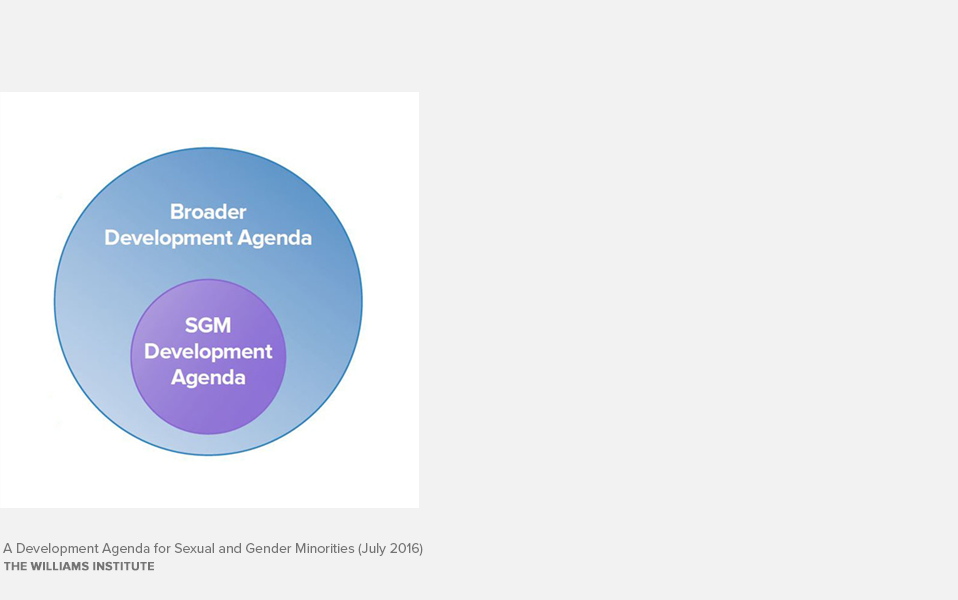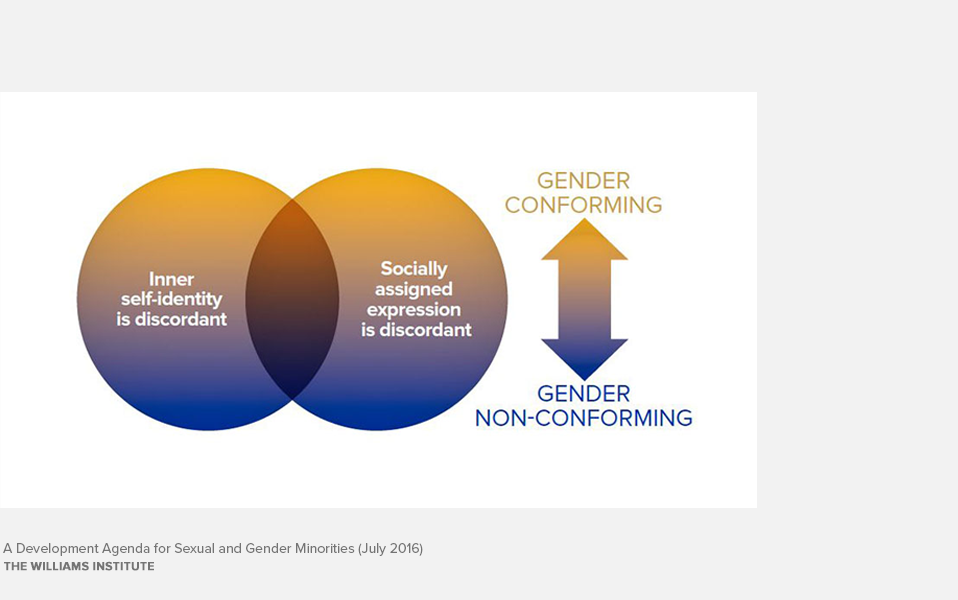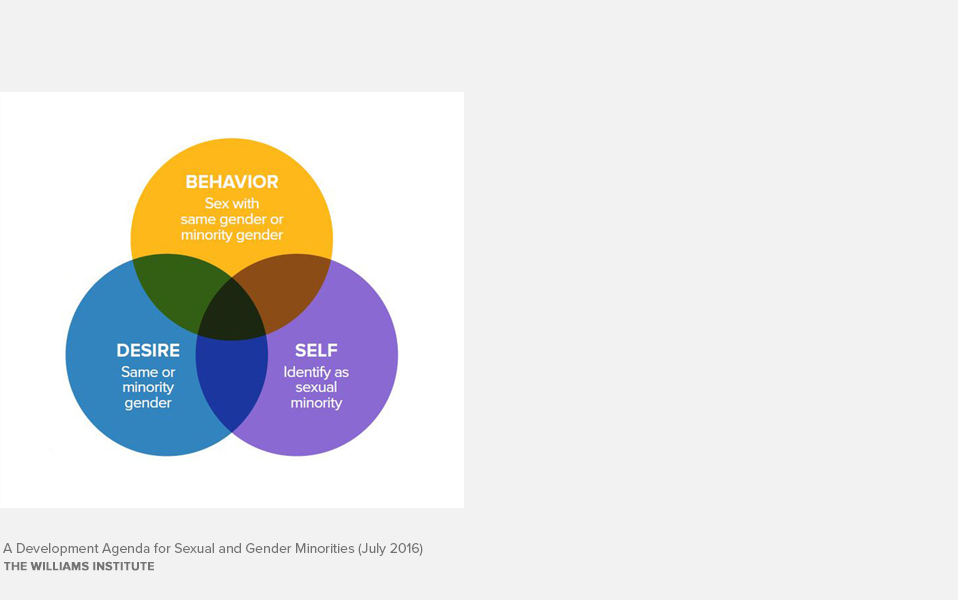Executive Summary
In the past few years major international development agencies have increasingly begun to identify sexual and gender minorities as a focus of concern. This concern is advanced by growing evidence of discrimination, violence and stigma faced by those who are, or are perceived to be, sexual and gender minorities. This paper is meant to highlight the following:
- research and evidence concerning the development of sexual orientation and gender identity (SOGI),
- a conceptual process for creating a development agenda that would respond to the needs of sexual and gender minorities, and
- an example of such an agenda based on globally recognized priorities for sexual and gender minorities.
The audience for this paper includes anyone who is interested in the task of creating a SOGI development agenda. This audience includes both those in the human rights community as well as those in the development community. The paper makes reference to development practitioners, being those who formulate and implement development policy and programs, including intergovernmental agencies as well as non-governmental groups and organizations which carry out development functions.
Frameworks: Human Rights, Economic Development, Human Development
Issues of sexual and gender minorities have received serious attention and support in the human rights arena, starting with the introduction of the “Brazil Resolution,” the formulation of the Yogyakarta Principles on the Application of International Law to Sexual Orientation and Gender Identity, and the advancement of supportive resolutions in the UN General Assembly. In the development arena, issues related to sexual and gender minorities have not enjoyed the same level of advancement. Though development and human rights frameworks are related, they each represent distinct sets of goals, varying scopes of applicability, and different means to evaluate public policy. This paper reviews each of these conceptual differences.
Development activities often focus on increasing individual well-being through economic growth and shared prosperity. Several frameworks can be used to explain the relationship between the inclusion of sexual and gender minorities and economic growth.
- Increased human capital leads to increased productivity and decreased disparities.
- Increased worker productivity leads to a more productive workforce and financially stronger households.
- Business productivity can be increased by increasing the diversity of the workforce and reducing limitations on how businesses convert labor into profits.
- A post-materialist demand for human rights increases support for rights in those countries that have experienced economic growth.
- Strategic Modernization theory suggests that countries with a more modern and open business environment will attract additional business.
The human development framework used by many in the international development community is called the “capabilities approach.” Under this approach, the goal of development is to enlarge people’s capabilities. Capabilities are real opportunities to lead a life of one’s own choosing, to make a living, have full health, education, a role in governance, and so on. The approach is “people-centered,” in that it relies on individuals to shape the development agenda which affects them, and it looks to evidence of individual development and well-being to determine whether development efforts are effective.
Creating a Development Agenda
Sexual and gender minority communities can use the capability approach to create a development agenda. That process involves several steps:
Engaging in a community based process. In keeping with the principle of self-determination embedded in the capabilities approach, the process for choosing development priorities should be conducted with the participation of those in the community who would be affected by development efforts.
Defining the populations to be targeted by development efforts. Designing, implementing and evaluating development efforts requires a clear understanding of who is to be impacted. Sexual orientation and gender identity are complex concepts that can be defined in multiple ways. This paper suggests that development efforts use definitions of sexual orientation and gender identity which have been articulated by demographers and social scientists. Gender minorities can be identified and grouped according to any one of three different criteria:
- People whose inner self-identity does not match gender assigned at birth.
- People whose gender expression (or socially assigned gender) does not match gender assigned at birth.
- People whose social expression does not conform to relevant cultural norms and expectations of gender.
Sexual minorities can be identified and grouped according to three separate criteria:
- People who describe themselves using sexual minority terminology.
- People whose sexual partners are the same gender, or a minority gender.
- People who experience attraction to individuals of the same or a minority gender.
Understanding human development needs of sexual and gender minorities.
Development policy should recognize and support the development of individuals as they form their personal identities. Psychologists have identified frameworks of identity formation, such as stage models, milestone models, and inclusive models, that can be used to understand how sexual and gender minorities develop in ways that support health and well-being. These theories all share a common list of capabilities that must be present: the capability to make choices, to have knowledge about one’s self, to have contact with other sexual and gender minorities, to live in a community, and to express one’s self. A development agenda should reflect these needs of sexual and gender minorities.
Legal standards can also support or inhibit development. For example, while nearly eighty countries criminalize homosexuality in some way, over sixty countries prohibit discrimination based on sexual orientation. For transgender people, a growing number of countries permit legal gender change; however, many do not and some that do require sterilization.
Cultural standards can be a significant obstacle to human development for sexual and gender minorities. Stigma and prejudice operate to constrain people’s lives through social and legal structures. These place demands on individuals in three different ways. The most strident is the demand to convert to heterosexuality and a gender identity that conforms to local norms. Criminalization, attempts at conversion therapy and curative rape are all examples of this demand. The second demand is to hide and pretend. This demand requires individuals to avoid disclosure or face exclusion. The last is the demand to downplay and disregard. This demand to appear less “flagrant” and more conforming, can arise from constant pressures to act according to acceptable stereotypes.
Each of these demands can contribute to poor health outcomes which limits full human development. Evidence demonstrates the existence of four specific processes through which social stigma and prejudice are manifested in the lives of sexual and gender minorities. These minority stress processes are: (1) chronic and acute prejudice events and conditions, (2) expectation of such events and conditions and the vigilance required by such expectation, (3) concealing or hiding of one’s lesbian or gay identity, and (4) internalization of social stigma (internalized homophobia or transphobia).
A SOGI Related Development Agenda
Based on the needs of sexual and gender minorities, the capabilities approach can be used to formulate development priorities. This paper looks at empirical evidence of the lived experience of sexual and gender minorities to identify eight capabilities that should be promoted by development policy.
A. Life’s course: each person should have the capability to progress through the course of each of life’s stages, from birth to death.
B. Health: each person should be able to have good health, including sexual and reproductive health, adequate nourishment and shelter, and access to resources that promote health and well-being.
C. Education: each person should be able to learn, receive training and education, and acquire knowledge of one’s self and one’s world.
D.Identity and expression: each person should be able to have self-determination, integrity, and security over their identity and body, with regard to how they perceive themselves and how they express their identity to others through behavior, appearance, social interactions and legal claims.
E. Affiliation and relation: each person should have the capability to establish and maintain intimate, family, and social affiliations as well as to become part of larger associations in the community.
F. Resources: each person should have access to, and control over, adequate resources to meet life’s needs, including the capability to earn a livelihood through decent, productive work.
G. Participate in governance: each person should be able to participate effectively in political choices that govern one’s life —having the ability to petition the government, speak and take peaceful action in support of and in opposition to political leaders, and to serve as political decision makers.
H. Safety and security: each person should have the capability to be safe from physical violence and emotional abuse, to live in a state of peace and personal security, and to expect and receive protection by those in authority.
Understanding Development Outcomes
Such a people-centered approach requires a strong basis of data about the lived experience of LGBT people. Sexual and gender minorities are an understudied population. Though instances of discrimination are well documented in all regions of the world, there has been very little quantitative research about development outcomes such as health, education, income, household structure. Seeking reliable information about the lived experience of sexual and gender minorities is a central priority. These populations should be included in demographic and household surveys, and subjective data gathered from sexual and gender minorities themselves should be used to inform us about the consequences of stigma and prejudice. Development agencies should create tools, such as indices and human development reports, to track the progress of sexual and gender minorities. In the same way that the Human Development Index has helped communicate development issues to policymakers and the general public, a SOGI development index can consolidate and communicate data about the well-being of sexual and gender minorities.
Download the full report


